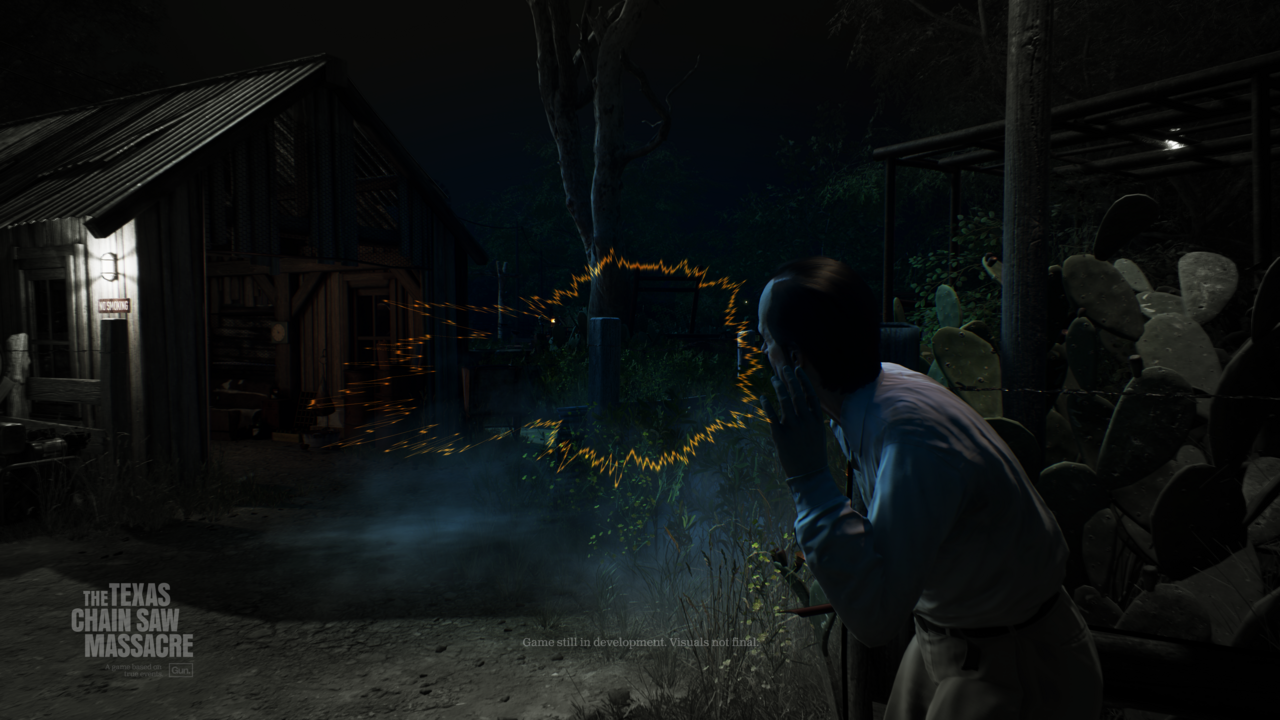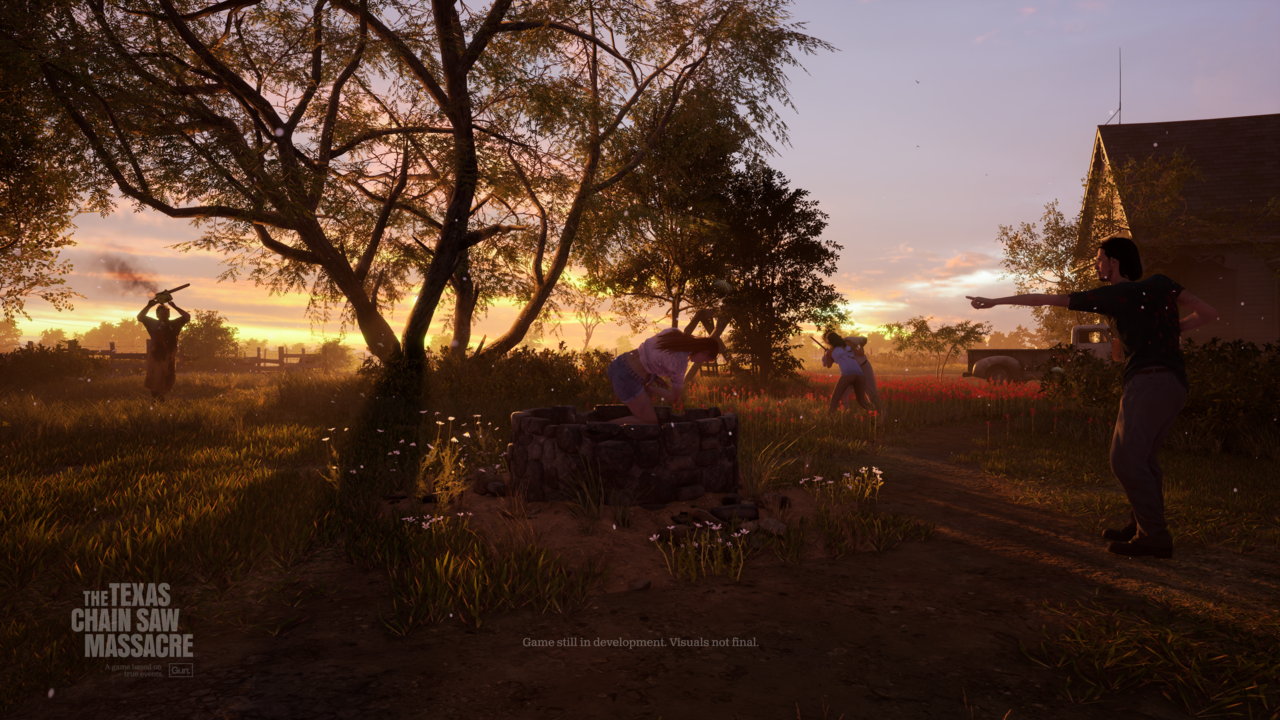The number of asymmetrical horror games has risen quickly over the last few years, with games such as Friday The 13th, Dead By Daylight, Evil Dead, and more giving players the chance to see the world through the eyes of both original monsters and licensed slashers--not to mention their hapless victims. No two of these games are the same, but Gun Interactive is one of a very small number of studios to work on a second, separate franchise within the genre. For the studio, moving from Friday The 13th's misty Camp Crystal Lake to the cruel Texas heat of The Texas Chain Saw Massacre is an undertaking that goes beyond setting and scenery.
While some lessons can be applied directly from one game to the other, a lot doesn't translate so easily, despite their broad strokes being similar. GameSpot recently got to go hands-on with next year's horror game and speak to the team about what it takes to bring this specific series to video games, what it's like to become a go-to team for horror adaptations, and how they ensure players will appreciate playing as more than just the series' mass-marketed monster.
Asymmetrical multiplayer and horror are like "chocolate and peanut butter," Gun Interactive CEO Wes Keltner told me, but not until Friday The 13th: The Game launched in 2017 was there a game where "all mechanics and features were built around" a licensed horror IP. Naturally, this drummed up thoughts in my mind of Dead By Daylight's way of retrofitting countless licensed monsters to its standard 4v1 setup and map layout. For Gun, to make a licensed horror game a second time demands something like a reinvention of the wheel for the team, because what worked there and then won't necessarily work here and now. "With Friday The 13th, there's one killer. With Texas Chain Saw, you're dealing with a whole family."
The game plays in 4v3 matches where four victims--notably not named "survivors," but instead "victims"--awaken already ensnared by the Slaughter family that consists of the hitchhiker, the cook, and, of course, Leatherface himself. In the 50 years since the original Tobe Hooper movie shocked audiences with its unflinching portrayals of violence, Leatherface has outgrown his own series in a way, partly due to marketing decisions, Keltner believes. As slashers blew up in the 1980s, Leatherface had to become the series' mascot, its face of evil who could stand tall next to Jason Voorhees, Freddy Krueger, Michael Myers, and the rest. But the original movie was much more focused on the family as a whole, so, in being a recreation of sorts of that 1974 film, the game does this too.
"One of the things about [The Texas Chain Saw Massacre] is it's oppressive, like when you watch it, there's a weight on you," Keltner added. "There's that feeling, as you're moving closer and closer to danger, that hope is being removed from you. And when we had those discussions, when we studied that film and had that design discussion, it kept coming back to that same sort of idea. To match that film, you got to have three family members running around constantly on you, and making you feel uncomfortable."
Might this annoy some players who really just want to be Leatherface? After playing it, I think not. Each killer has their own unique skill set, and they'll need to work together to kill off the foursome of victims and prevent anyone from escaping. Playing as two of them, I enjoyed them in different ways thanks to how they each bring crucial abilities to the objective.
The hitchiker is more nimble, so he can crawl through small spaces and set reusable traps, like bear traps made partly of bone that can be placed in front of generators the victims will be desperate to deactivate. The cook is a little slower and older, but he can listen closely and pinpoint the survivors' locations even when they're very quiet. Leatherface likely needs no introduction, but his intimidating chainsaw also manages to destroy obstacles that would give victims some breathing room, such as clusters of furniture in a hallway or even locked doors. There's also a fourth, non-playable family member--the rocking-chair-bound Grandpa, who villains can feed blood from victims and enjoy his sonar-like perks, though victims can sneak into his room and decommission the immobile old man.

"There's a difference in balancing, which is always a tricky word to talk about when you're mentioning asymmetrical horror," Keltner said. "It's not supposed to be balanced, that's the definition of asymmetric, right? But when you have three villains running around, what it creates is far more diverse gameplay and replayability. In Friday The 13th, if Jason shows up and he's a very aggressive, brutal, in-your-face player, then you kind of get an idea of how the match is going to kind of play out. Whereas in this, you may have two aggressive [players] and then maybe one that's playing a little bit more cheeky, a little bit more stealthily, or however they want to play. And that formula changes each time because it's all human-driven. It's all human decision, right? We give you the tools, we give you the mechanics, the abilities, to play the ways that you want to play. And that makes for a rich type of gameplay, that every time you reset and everyone picks different roles, you feel that it plays like a different game."
This novel approach to the genre, giving the killers nearly as many players as the victims, demands victims who can feel somewhat empowered as well, but because it's The Texas Chain Saw Massacre, this will never be a power fantasy. On the map I played, getting off the property was the only win scenario. There are no cops to call, and Tommy Jarvis isn't going to show up with his shotgun like he does on the campgrounds of Gun's past effort.
Each victim also has their own unique ability, however. Like the killers, it's the tactical confluence of all these abilities that will lead to success. You'll need Connie's ability to instantly open locked doors, thus bypassing the skill-check mini-game, just as much as you'll need Leland's ability to lower his shoulder and knock villains off their feet, buying the group some time. Both killers and victims have lengthy skill trees too, though I wasn't able to explore them in detail during my hour or so with the game. As usual in this genre, the give-and-take of deciding when to save an ally versus when to write them off as dead weight makes The Texas Chain Saw Massacre an interesting social experiment on top of its intentions of being a creepy multiplayer game.
The map is full of details that serve the gameplay for both teams without breaking the illusion that you're in a wretched, hopeless place. Gun wants players to feel like they're in the movie themselves, so the ample number of locked doors, small crevasses used for sneaking, darkened corners in the grotesque basement, and fast-evaporating escape routes manage to keep the house grounded in reality without it feeling too video-gamey.
My favorite map details are the open wells outside. The outdoor space is pretty vast on the one of three announced maps I played, but it's not wasted space. When you're being chased for your life, limping just out of the reach of an assailant, perhaps through the sunflowers or around the shed, you can decide to quickly jump down into a well because the villains can't follow you that way. But it's no salvation. It leads you back into the basement, otherwise known as Leatherface's Lair. The decision to escape to momentary safety by heading back inside the house is truly the stuff of horror movies. Rather than yell at the screen when the protagonist does something foolish, here you'll realize how necessary such a maneuver can sometimes be.

The labyrinthine Slaughter family household was reborn in intricate detail. As a horror buff, I admit I found it mesmerizing to move around in that space. We can't see all aspects of the house so easily in the movie, since usually people are running and screaming through each section of it, so the team has rather painstakingly poured over the aged film frame-by-frame to ensure the game's recreation of that space is authentic.
"The other day, I told our developers, 'Hey, I just saw approximately, like, four frames of the film, there's a light switch at the top of the stairs in this location.'" Executive producer Ismael Vicens told me. "And we'll go ahead and we throw that in there. For us, it's caring about those exact, specific moments, so that anyone who knows the movie as well as we do, they're gonna look at it and just say, 'Yep, they got it.'"
The team is comprised of "horror nerds," Keltner added, who described the great lengths to which Gun included the faithful chainsaw audio. "We located the make, model, and year of the Poulan chainsaw, we found two or three of those[...]got parts, rebuilt it, got it running, and then captured all the sound of that exact saw. We hired Watson Wu, who is a world-renowned sound effects and foley artist. And we're assured that we got the exact sound of that saw. We didn't want to go to some website that sells stock sound files and just go 'Oh it's a chainsaw. I'll just stick it in there.' That would be the easy thing to do." He added that the team even studied the migratory patterns of birds to ensure the ambient bird sounds players may pick up--between bouts of chainsaw-revving and screaming--are accurate to the setting. "If you're gonna put it in there, do it right."
These small touches are part of why Gun has been in contact with around a dozen different horror franchise rights-holders, Keltner revealed. "Sometimes it's just like one movie studio that comes to me and they send me a PDF that has like 60-something IPs on it. And they're like, 'Pick one.' And I'm like, 'That's not how this works,'" adding that the team is meticulous with whom it collaborates, seeking partners who both understand video games and will be appropriately generous with the way the team can use the IP. "We have seen more and more of these [asymmetrical horror games] come to market, but it's just not how Gun Interactive is as a studio. We're highly selective on who we choose to work with and what games we want to bring to market, and they kind of have to pass the sniff test here internally."
Noticing and appreciating the game's finer details that have helped grow Gun into a horror name brand in a short timespan will take a lot more playing time than I've had so far, and no doubt more playtime will likely reveal pain points, as well, but it's worth noting that while Friday The 13th was a fun but oftentimes janky game, The Texas Chain Saw Massacre already feels much smoother, with better-controlling characters, more digestible objectives and UI, stronger animation work, and a much more detailed landscape. It all comes together thanks to the authenticity that, I expect, will excite fans like me who are always seeking new experiences in video game horror--a somehow still underserved genre.
The first time I saw that infamous metal door, or the red wall lined with animal skulls at the top of the stairs, I immediately felt like I knew this place that was, as a player, still totally new to me. Faithful video game adaptations of other visual media can uniquely immerse players who bring with them a level of familiarity, and for me today, that means an eagerness to get back into that house despite knowing the horrors that await within it.





